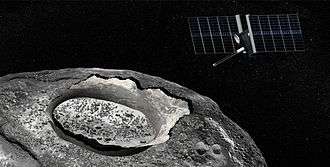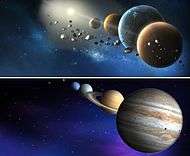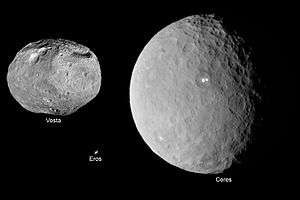Psyche (spacecraft)
 | |
| Mission type | Reconnaissance |
|---|---|
| Operator | NASA |
| Mission duration | 2 years (proposed) |
| Start of mission | |
| Launch date | 2020 (proposed) |
| 16 Psyche asteroid orbiter | |
| Orbital insertion | 2026 (proposed)[1] |
Psyche is a proposed orbiter mission concept to explore the origin of planetary cores by studying the metallic asteroid 16 Psyche. This asteroid may be the exposed iron core of a protoplanet, likely the remnant of a violent collision with another object that stripped off the outer crust. Lindy Elkins-Tanton of Arizona State University in Tempe, Arizona is the Principal Investigator, who proposed this mission to NASA's Discovery Program. NASA's Jet Propulsion Laboratory would manage the project.
Asteroid 16 Psyche is the heaviest known M-type asteroid, and is thought to be the exposed iron core of a protoplanet.[2] Radar observations of the asteroid from Earth indicate an iron–nickel composition.[3]
Overview
.png)
Psyche was selected on 30 September 2015 as one of five semifinalists for the Mission #13 of the Discovery Program.[4] The winner will be chosen around December 2016[5] and must be ready to launch by the end of 2021.[6][7] The Psyche spacecraft would use solar electric propulsion,[8] and the notional payload would be an imager, a magnetometer, and a gamma-ray spectrometer.[8][9]
The mission would launch in 2020 and arrive in 2026 for a year of science.[1] Data shows 16 Psyche asteroid to have a diameter of about 252 km (157 mi).[10]
Objectives
Differentiation was a fundamental process in shaping many asteroids and all terrestrial planets, and direct exploration of a core could greatly enhance understanding of this process. The Psyche mission would characterize 16 Psyche's geology, shape, elemental composition, magnetic field, and mass distribution. It is expected that this mission will increase the understanding of planetary formation and interiors. The science questions this mission will address are: [11]
- Is asteroid 16 Psyche the stripped core of a differentiated planetesimal, or was it formed as an iron-rich body? What were the building blocks of planets? Did planetesimals that formed close to the Sun have very different bulk compositions?
- If 16 Psyche was stripped of its mantle, when and how did that occur?
- If 16 Psyche was once molten, did it solidify from the inside out, or the outside in?
- Did 16 Psyche produce a magnetic dynamo as it cooled?
- What are the major alloy elements that coexist in the iron metal of the core?
- What are the key characteristics of the geologic surface and global topography? Does 16 Psyche look radically different from known stony and icy bodies?
- How do craters on a metal body differ from those in rock or ice?
See also
- DAVINCI (spacecraft)
- Iron meteorite
- Lucy (spacecraft)
- Near-Earth Object Camera (NEOcam)
- VERITAS (spacecraft)
References
- 1 2 Hand, Eric (20 September 2015). "Venus and a bizarre metal asteroid are leading destinations for low-cost NASA missions". Science Insider. Retrieved 2015-10-01.
- ↑ Elkins-Tanton, L. T.; et al. (March 2014). "Journey to a Metal World: Concept for a Discovery Mission to Psyche" (PDF). LPI Contribution No. 1777. 45th Lunar and Planetary Science Conference. p. 1253. Bibcode:2014LPI....45.1253E. Retrieved 2016-11-11.
- 1 2 33th Largest Asteroid, 16 Psyche
- ↑ Brown, Dwayne C.; Cantillo, Laurie (30 September 2015). "NASA Selects Investigations for Future Key Planetary Mission". NASA News. Washington, D.C. Retrieved 2015-10-01.
- ↑ Clark, Stephen (September 7, 2016). "NASA official says new mission selections on track despite InSight woes". Spaceflight Now. Retrieved 2016-09-08.
- ↑ Clark, Stephen (24 February 2014). "NASA receives proposals for new planetary science mission". Space Flight Now. Retrieved 2015-02-25.
- ↑ Kane, Van (December 2, 2014). "Selecting the Next Creative Idea for Exploring the Solar System". Planetary Society. Retrieved 2015-02-10.
- 1 2 Kane, Van (19 February 2014). "Mission to a Metallic World: A Discovery Proposal to Fly to the Asteroid Psyche". The Planetary Society. Retrieved 2015-10-01.
- ↑ Wampler, Stephen (November 4, 2015). "Lab-Johns Hopkins team tapped to work on possible NASA effort to explore asteroid". LLNL Newsline. Retrieved 2015-12-21.
- ↑ "JPL Small-Body Database Browser: 16 Psyche". Retrieved 2015-10-01.
- ↑ Elkins-Tanton, L.T.; Asphaug, E.; Bell, J.; Bercovici, D.; Bills, B.G.; Binzel, R.P.; Bottke, W.F.; Jun, I.; Marchi, S.; Oh, D.; Polanskey, C.A.; Weiss, B.P.; Wenkert, D.; Zuber, M.T. (2014). "Journey to a Metal World: Concept for a Discovery Mission to Psyche" (PDF). 45th Lunar and Planetary Science Conference (2014). Universities Space Research Association. Archived (PDF) from the original on 2014-02-27.
External links
- Metal Asteroid Psyche — Infographic at Space.com




